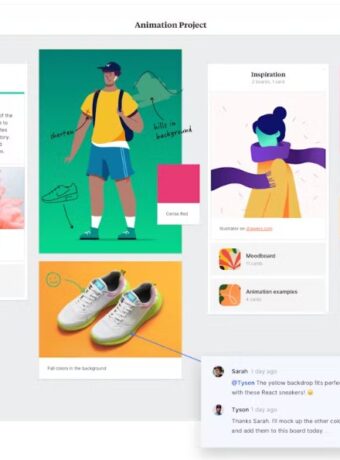How Can You Make Your Brand More Unique?
As a business owner, you should know how to make your brand unique is key to standing out from the competition and driving customer loyalty. From your logo design to your marketing messages, it’s important to keep your brand identity distinct and memorable. But how can you make sure that your branding is both creative and meaningful? In this blog post, we’ll share with you some proven strategies for crafting a unique brand presence. With these tips in hand – like avoiding clichéd visuals or generic messaging – building an innovative image that reflects the values of both you and your customers will be easy!

Making your brand more unique can help it stand out from competitors and better resonate with your target audience.
Define your brand personality
Define your brand personality and values that are unique to your brand. This will help you create a unique voice and tone for your brand that differentiates it from competitors and resonates with your target audience.
Defining your brand personality is an important step in creating a unique and differentiated brand. Here are some steps you can take to define your brand personality:
- Understand your target audience: Start by understanding your target audience, including their values, preferences, and needs. This will help you create a brand personality that resonates with them.
- Identify your brand’s values: Identify the values that your brand embodies. This can include things like innovation, quality, sustainability, or customer service. These values should align with both your business objectives and the needs and preferences of your target audience.
- Determine your brand’s voice and tone: Determine the voice and tone you want to use when communicating with your target audience. Your brand voice should reflect your brand’s personality and values and be consistent across all communication channels.
- Create a brand persona: Create a brand persona that embodies your brand personality. This can include details like the brand’s age, gender, interests, and personality traits. This will help you create a more relatable and humanized brand that resonates with your target audience. Read more:
How To: Define Your Ideal Customers And Customer Archetypes - Use emotion to connect with your audience: Use emotions to connect with your target audience. Emotions are a powerful tool for creating a strong and lasting connection with customers. Think about how your brand can evoke emotions like joy, trust, or excitement.
- Be authentic: Above all, be authentic in your branding. Your brand personality should reflect the true essence of your brand and be consistent across all touchpoints.
Overall, defining your brand personality requires a deep understanding of your target audience, your brand’s values, voice, and tone, creating a brand persona, using emotions to connect with your audience, and being authentic.

Identify your Unique Selling Proposition (USP)
Identify what makes your brand unique and different from competitors. This could be your product, service, or the way you do business. Communicate this USP consistently throughout your branding to create a unique selling point that sets your brand apart.
Your Unique Selling Proposition (USP) is what sets your brand apart from competitors and gives you a competitive advantage in the market. Here are some steps you can take to identify your USP:
1. Understand your target audience:
Start by understanding the needs and preferences of your target audience. This will help you identify the features or benefits of your product or service that are most important to them.
Understanding your target audience is essential to effective communication and marketing. Knowing who you’re trying to reach – their needs, interests, levels of understanding, and any potential key demographics – provides invaluable insights that allow you to craft messages that are informed and easily understood by your target market. Thorough research into these areas enhances your ability to engage meaningfully with your target audience while establishing credibility as a business or organization. Knowing your target audience will ensure you can effectively target the right people with the right message at the right time.
2. Analyze your competitors:
Analyze your competitors to identify what they are offering and how they are positioning themselves in the market. This will help you identify gaps in the market that your brand can fill.
Analyzing your competitors is an integral part of a successful branding strategy. With the right knowledge and research, you can uncover your competitors’ strengths and weaknesses, identify opportunities for improvement, analyze their marketing plans, and analyze their target customer base. Not only does this help you create a more effective plan for your own business, but it can also give you a better understanding of the wider industry as well. It’s essential to stay on top of what your competitors are doing while also setting yourself apart with an innovative approach.
3. Identify your strengths:
Identify the strengths of your product or service, including any unique features or benefits that competitors do not offer. These could be things like a better quality product, faster delivery times, or superior customer service.
Identifying the strengths of a brand is critical for any business’s success. It entails taking a careful look at the company’s products or services, mission statement, and overall goals in order to identify what sets it apart from its competitors. Through this analysis, businesses can identify their unique advantages and leverage them to achieve long-term sustainability in the market. Additionally, once strengths are identified, they should be highlighted when it comes to marketing and advertising campaigns to really drive home the message that shows why customers should choose a particular brand over another. A strong understanding of these important elements allows any business to identify its core strengths, ensuring future success.
4. Define your brand promise:
Define your brand promise, which is a statement that communicates the unique benefit your brand delivers to customers. This should be a clear and concise statement that communicates the value your brand provides.
A brand promise is a statement that accurately captures the essence of what you offer and assures that customers’ needs will be met when they engage with your company – from the product or service you deliver to the customer service experience. Creating a compelling and relevant brand promise helps to define, guide and reinforce both internal and external activities, so it’s essential to define a meaningful, resonant brand promise that accurately reflects your unique value proposition.
5. Test your USP:
Once you have identified your USP, test it with your target audience to ensure that it resonates with them and communicates the unique value your brand provides.
A Unique Selling Point (USP) can often be the factor that sets your product or service apart from the competition, so it is worth taking the time to test yours. Testing your USP involves considering how you market yourself if you’re making full use of customer insights, and making sure it reflects current needs. Striking a balance between understanding what your consumers expect and promoting yourself in the most effective way possible is key to testing effectively your USP. Analyze data and review feedback to test if it both appeals to customers while maintaining authenticity. Taking time to test a strong USP will be an investment that will pay off in the long run.
Identifying your USP requires a deep understanding of your target audience, analyzing competitors, identifying your strengths, defining your brand promise, and testing your USP.
Create a memorable visual identity
Create a memorable visual identity for your brand, including a distinctive logo, color palette, typography, and imagery. This will help your brand stand out and be easily recognized by customers.
Creating a memorable brand through visual identity is essential in today’s competitive marketplace. An effective brand should tell a story, evoke emotion, and be recognizable in the eyes of customers. The key to creating a successful brand is to have an attractive visual identity that stands out from the crowd. This includes knowing well brand anatomy and making use of colors, symbols, fonts, images, and logos that strengthen brand recognition. Ultimately, it’s important to remember that creating visually compelling brand experiences is vital for developing customer loyalty and trust.
Learn all about visual branding personalities:
- Group 1- Brand Design 1: How To Brand a Youthful, Open, and Happy Business
- Group 2- Brand Design 2: How To Brand an Elegant, Feminine Business
- Group 3- Brand Design 3: How To Style an Earthy, Community-Focused Business
- Group 4- Brand Design 4: How To Brand a High-End, Luxury Business

Personalize the brand experience
Personalize the brand experience for your customers. This can include customized packaging, personalized messaging, or personalized customer service. By offering a personalized experience, you can create a unique connection with your customers that sets your brand apart.
Personalizing the brand experience is all about creating a unique and memorable experience for each individual customer. Here are some steps you can take to personalize the brand experience:
- Collect data: Collect data on your customers, including their preferences, purchase history, and behavior. This data can be used to create personalized experiences that cater to their specific needs and interests.
- Segment your audience: Segment your audience based on demographic or behavioral data. This will help you create targeted campaigns and experiences that resonate with each group.
- Customize communication: Customize your communication with customers to make them feel valued and heard. This could include addressing them by name in emails, sending personalized offers, or tailoring your messaging to their interests.
- Personalize product and service offerings: Personalize your product and service offerings based on the needs and preferences of your customers. This could include offering customized recommendations, personalized products, or tailored services.
- Use technology: Use technology like artificial intelligence, machine learning, or predictive analytics to create personalized experiences for customers. This could include personalized product recommendations, targeted marketing campaigns, or customized web experiences.
Personalizing the brand experience requires collecting data, segmenting your audience, customizing communication, personalizing product and service offerings, and using technology. By focusing on these areas, you can create a unique and memorable experience for each individual customer that helps build brand loyalty and drives business growth.
Innovate
To be innovative and explore new ideas and ways of doing visual branding, identify the current trends: start by identifying the current trends in visual branding that are popular in your industry. Look at what your competitors are doing, what your customers are responding to, and what is working well in the market.
Also, brainstorm new ideas – once you have a good understanding of the current trends, start brainstorming new ideas and ways of doing visual branding that is different and unique. Think about what sets your brand apart and how you can communicate that visually.
Consider your brand personality. Your brand personality should be reflected in your visual branding. Think about the tone, voice, and character of your brand and how you can communicate that through visual elements. Experiment with different visual elements such as typography, color schemes, imagery, and layouts. Test out different combinations and see what works best for your brand.
- Incorporate user feedback: Incorporate feedback from your users to refine your visual branding. Ask for feedback from your customers and use their input to improve your branding.
- Continuously evolve: Visual branding is not a one-time effort. Continuously evolve your branding to stay relevant and resonate with your target audience.
Being innovative and exploring new ideas and ways of doing visual branding requires identifying current trends, brainstorming new ideas, considering your brand personality, experimenting with different visual elements, incorporating user feedback, and continuously evolving.
Conclusion
Overall, making your brand more unique requires a combination of defining your brand personality, identifying your USP, creating a memorable visual identity, personalizing the brand experience, and innovating. By focusing on these areas, you can create a brand that stands out and resonates with your target audience.
Crafting a unique brand identity involves considering the visuals, messaging, and values that you want your customers to associate with your business. By avoiding generic or clichéd visuals, catchy taglines, and cookie-cutter messages – all of which don’t allow for enough distinction between yourself and competitors – reducing customer confusion will be easier.
Get started today on implementing some of these proven strategies, such as using imagery that is new and unexpected, in order to create an innovative brand presence that speaks to both you and your customers. So ask yourself – how can you make your brand more unique? Take action now to stand out from the competition and start building customer loyalty with an effective branding strategy!
Read more about branding:
E-book: Branding For Creatives
What is Visual Branding and How It Can Help Your Business
How To Create Brand Brief
Brand Anatomy – What Is It, And What Are Its Key Elements?
Last Updated on 05/03/2025 by Victoria Silber






